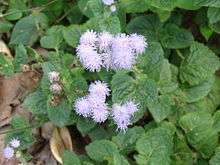Ageratum conyzoides
| Ageratum conyzoides | |
|---|---|
 | |
| Scientific classification | |
| Kingdom: | Plantae |
| (unranked): | Angiosperms |
| (unranked): | Eudicots |
| (unranked): | Asterids |
| Order: | Asterales |
| Family: | Asteraceae |
| Tribe: | Eupatorieae |
| Genus: | Ageratum |
| Species: | A. conyzoides |
| Binomial name | |
| Ageratum conyzoides L. 1753 not Hieron. 1895 nor Sieber ex Steud. 1840[1] | |
| Synonyms | |
|
Synonymy
| |
Ageratum conyzoides (billygoat-weed, chick weed, goatweed, whiteweed) is native to Tropical America, especially Brazil, and considered an invasive weed in many other regions. Herb 0.5–1 m. high, with ovate leaves 2–6 cm long, and flowers are white to mauve.[2]
In Vietnamese, the plant is called cứt lợn (meaning "pig feces") due to its growth in dirty areas.[3]
Uses
As a medicinal plant, Ageratum conyzoides has limited uses due to its toxicity. It is also an insecticide and nematicide.[4]
Toxicity
Ingesting A. conyzoides can cause liver lesions and tumors.[5][6] There was a mass poisoning incident in Ethiopia as a result of contamination of grain with A. conyzoides.[7] The plant contains the pyrrolizidine alkaloids lycopsamine and echinatine.
Weed risk
A. conyzoides is prone to becoming a rampant environmental weed when grown outside of its natural range. It is an invasive weed in Africa, Australia, Southeast Asia and the USA.[8][9] It is considered a moderate weed of rice cultivation in Asia.[10]
References
- ↑ Tropicos search for Ageratum conyzoides
- ↑ "Ageratum conyzoides". NSW Flora Online.
- ↑ vi:Cứt lợn
- ↑ Ming, L.C. (1999). "Ageratum conyzoides: A tropical source of medicinal and agricultural products". In Janick, J. Perspectives on new crops and new uses. Alexandria VA: ASHS Press. pp. 469–473. ISBN 0961502703.
- ↑ Sani, Y.; Bahri, S. (1994). "Pathological changes in liver due to the toxicity of Ageratum conyzoides". Penyakit Hewan. Indonesia. 26 (48): 64–70. ISSN 0216-7662.
- ↑ Fu, P.P.; Yang, Y.C.; Xia, Q.; Chou, M.C.; Cui, Y.Y.; Lin G. (2002). "Pyrrolizidine alkaloids-tumorigenic components in Chinese herbal medicines and dietary supplements" (PDF). Journal of Food and Drug Analysis. 10 (4): 198–211.
- ↑ Wiedenfeld, H. (2011). "Plants containing pyrrolizidine alkaloids: toxicity and problems.". Food Additives & Contaminants: Part A. 28 (3): 282–292. doi:10.1080/19440049.2010.541288.
- ↑ Global Compendium of Weeds, Ageratum conyzoides (Asteraceae)
- ↑ Alan S. Weakley (April 2008). "Flora of the Carolinas, Virginia, and Georgia, and Surrounding Areas".
- ↑ Caton, B.P. (2004). A Practical Field Guide to Weeds of Rice in Asia. Int. Rice Res. Inst. pp. 16–17. ISBN 978-971-22-0191-2.
External links
- Plants For Future: Ageratum conyzoides
- Tropical Plant Database: Ageratum conyzoides
- (Portuguese) Ageratum conyzoides photos
- Ageratum conyzoides L. Medicinal Plant Images Database (School of Chinese Medicine, Hong Kong Baptist University) (traditional Chinese) (English)
- Ageratum conyzoides in West African plants – A Photo Guide.
| Wikimedia Commons has media related to Ageratum conyzoides. |
Gallery
-

From Kerala.



